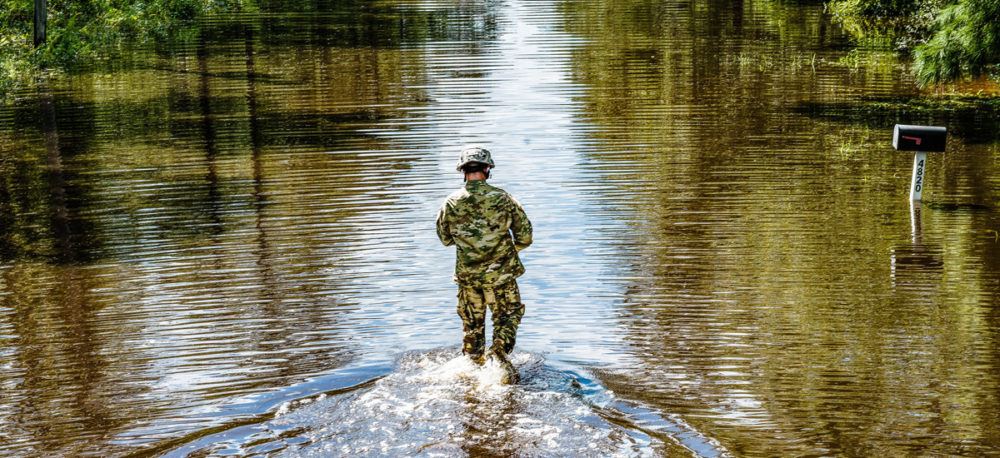Picture this: You’ve just completed a decade of investing about $3 billion of your customers’ dollars into keeping the lights on when severe weather strikes. Now Hurricane Irma’s blasted through, 90 percent of your customers were left in the dark, and the restoration and repair costs you intend to bill them are estimated at $1.3 billion.
That’s right. A storm you’ve spent a decade preparing for is looking like it’ll end up costing nearly half as much as the preparations themselves. Worse, there’s no reason to think it won’t keep happening again, and again, and again, as climate change drives the intensity of these storms ever higher.
Bit of a thorny customer relations problem, that one.
Which is why the usual way of recovering storm restoration costs—as an additional line item on customers’ monthly bills—isn’t exactly “convenient.” That’s because it serves as a repeated reminder and ongoing invitation to your ratepayers and regulators to question just how come it is that all those billions in investments still result in such high costs.
Enter the late 2017 tax cuts and Florida Power & Light’s (FPL) sweet, sweet sigh of relief.
Magical Money Magically Solves Climate Problem?
Over the past month or so, utilities across the country have been hauled in front of their regulatory commissions and asked about how they intend to funnel tax cut windfalls back to the ratepayer. In turn, plans to reduce customer rates are beginning to emerge.
But FPL? With tax cuts, it saw an open lane and it drove straight to the basket.
As opposed to charging ratepayers monthly storm costs, the utility realized that it could instead deploy those freed up funds to, in effect, wipe away the storm. No monthly charges, no monthly reminders, no more problem.
On its surface, there doesn’t seem to be anything outright wrong with this accounting approach. In fact, it could end up saving ratepayers some amount of money through economic efficiencies—I leave that part to the regulators.
Here’s the problem I do have.
FPL’s experience with Hurricane Irma should have been an eye-opener to every utility, every regulator, every policymaker, every planner—every person—in this country. Here’s a utility that has worked hard on doing better, made big-time ratepayer investments to back those efforts up, and was still left with 90 percent of its customers in the dark, including 12 senior citizens who died as the outages—and ensuing lack of air conditioning—dragged on.
Now overall, many of FPL’s outages from Hurricane Irma were resolved fairly quickly, which is a primary goal of boosting grid resilience. Indeed, it’s not just about minimizing the initial scale and scope of the outage, but also minimizing the time an outage lasts should one come to pass.
The thing is, that relatively quick recovery cost FPL—and thus ratepayers—a staggering $1.3 billion. So even if we did accept the magnitude and duration of the outage given the size of the storm, we’re left with the glaring realization that we may not keep being able to afford the fix. The unsustainability of the plan is even more apparent when we consider that we have every reason to believe these storms won’t be getting any more docile in the years to come, especially in a place like FPL’s territory, where sea level rise is making storm surge worse, rapidly placing ever more critical infrastructure at risk.

According to NOAA’s tracking, billion-dollar weather events in the United States show no sign of slowing down. In 2017 alone, these disasters totaled more than $300 billion in costs.
This storm should result in people asking hard questions. Raising red flags. Demanding dialogue. Saying hey, we might just need to make a change.
But instead what FPL’s proposing to do is kick the can down the road. It’s putting a damper on ratepayer reactions, minimizing run-ins with regulators asking pesky follow-ups, and buying itself a bit more time before the (inevitable) question of if not this, what.
Because let’s face it: there won’t always be a magical tax reform to solve the climate problem. These costs are real, and these questions will come. Ratepayers deserve to have them asked after this $1.3 billion instead of the next.
But for now, it’ll be largely left to just five commissioners (and at least one hurricane-response docket) instead of the ongoing and motivated voices of a constantly reminded nearly 5 million customers. Again, that’s not necessarily wrong, just incredibly unhelpful.
The Conversations We Should Be Having
Here’s one thought on a place for the conversation to start: recognizing that if today’s “good enough” isn’t really good enough, then perhaps it’s the approach itself that must change. We see a viable path to the future through the concurrent pursuit of a two-pronged approach:
- Steadily increase grid resilience:
- There’s a lot that can be done to improve the performance of the grid, from replacing wooden poles with reinforced concrete, to burying select power lines, to elevating flood-exposed substations, to installing smart devices across the system—all of which FPL has pursued, at least in part. But there’s also a broader need to shift the whole of the system from one that’s oriented around central generating stations, to one that’s powered by ever more decentralized and distributed clean energy resource—and here, FPL has seriously lagged (and dragged much of the rest of the state down with it by not using its heft to push for broader climate and clean energy action).
- It’s also critically important for everyone to have on hand a shared vision of the future, and a plan for how to get there. That way every time there’s an upgrade or emergency repair, the grid gets smarter, stronger, and one step closer to that future state. Yet we can’t expect utilities and regulators to go it alone—we need the federal government to help in establishing guiding resilience principles and disseminating best practices along the way.
- Ensure continuous power for those who can’t afford to go without:
- It will take time to achieve wholesale grid modernization, and even when we get there, we should still assume that the power will still, sometimes, go out. As a result, we must identify those populations and critical services for whom even a brief disruption is too much, and arm them with an electricity Plan B. This must be equitable and just, foremost through engagement with the communities themselves.
- One top option for keeping the lights on? Ensuring that utilities have allowed a clear path for the individual installation and use of solar panels alongside storage, which can provide users with benefits year-round—not just when the electricity blinks out.
As much as we may not want to face it, preparing for climate impacts will cost real, significant, mind-bending amounts of money. And that means trade-offs. And that means dialogue. Everywhere. Not just with FPL—after all, other Florida utilities quickly jumped to follow FPL’s accounting lead—and not just in Florida (or Texas, or Puerto Rico, or California, or…). Everywhere we need to be asking these hard questions and having these hard conversations, all so that we can begin to set a course to a better tomorrow.
Using accounting maneuvers to mask the true costs of climate preparedness? Not the best conversation starter.
But though we may have lost this prompt, it doesn’t mean the conversation can’t go on.

